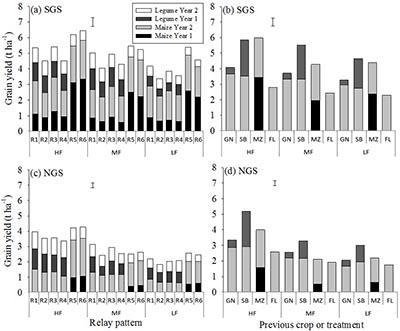In my last update, I presented portion of my second paper published in Field Crops Research (https://authors.elsevier.com/sd/article/S037842901730727X).
In this Podcaster, I present a short summary of my third paper recently published in Experimental Agriculture: Kermah, M., Franke, A.C., Ahiabor, B.D.K., Adjei-Nsiah, S., Abaidoo, R.C., & Giller, K.E., (2018). Legume-maize rotation or relay? Options for ecological intensification of smallholder farms in the Guinea savanna of northern Ghana. Experimental Agriculture, 1–19. https://doi.org/10.1017/S0014479718000273.
The increasing demand for food associated with the growing population in West Africa necessitate the intensification of crop production. Legume-cereal rotation have thus dominated the smallholder farming systems due to the increased yields of maize following legumes relative to continuous sole cropping of maize. Hence, many studies in the region have largely concentrated on sole crop legume-maize rotations. However, the erratic rainfall pattern in the Guinea savanna presents a risk of possible crop failure in sole cropping that can extremely threaten household food, nutrition and income given that the area has only one cropping season a year. Crop diversification and intensification system that retain the recommended planting density of sole maize with a grain legume added may provide food in case of poor rainfall and failure of the maize. This study explored a diversity of short duration cowpea and maize relay cropping systems that could contribute to mitigating risks of crop failure in sole cropping and increase food production. These were compared with continuous maize and rotations of soybean, groundnut and fallow with maize in farmers’ fields differing in soil fertility in the southern and northern Guinea savanna agro-ecological zones of northern Ghana.
|
Fig. 1. Maize and legume grain yields as influenced by different relay and rotation cropping sequences and soil fertility status in both years in southern Guinea savanna (SGS) and northern Guinea savanna (NGS). Error bars indicate the combined standard error of differences between means for the different cropping patterns across soil fertility status. |
 |
Sowing maize first with cowpea sown at least 3 weeks after sowing (WAS) the maize led to a 0.18–0.26 t ha-1 reduction in cowpea grain yield compared with cowpea sown from the beginning (Fig. 1). Sowing cowpea first followed by maize sown at least 2 WAS the cowpea resulted in a 0.29–0.82 t ha-1 reduction in maize grain yield relative to maize sown from the onset due to less rainfall received by the relay maize (Fig. 1). Groundnut and soybean induced 0.38–1.01 t ha-1 more grain yield of a subsequent maize than a continuous maize, and 1.17–1.71 t ha-1 more grain yield than the relay systems (Fig. 1). The results indicate that a rotation of soybean or groundnut with maize is superior in increasing subsequent maize yield than relay cropping of maize and cowpea, and a maize succeeding a natural fallow in rotation. However, accumulated crop yields over two years were comparable between soybean-maize rotation and the relay system where maize was sown first followed by a cowpea, while that relay system was more productive than the other cropping systems (Fig. 1). This indicate that sowing maize first and cowpea relayed into it is a promising ecological intensification option alternative to the more common legume-maize rotation in the Guinea savanna and recommended when the growing season is short due to late onset of rainfall.
Michael Kermah, Wageningen University & Research, The Netherlands (Click here for his 2017 update)
